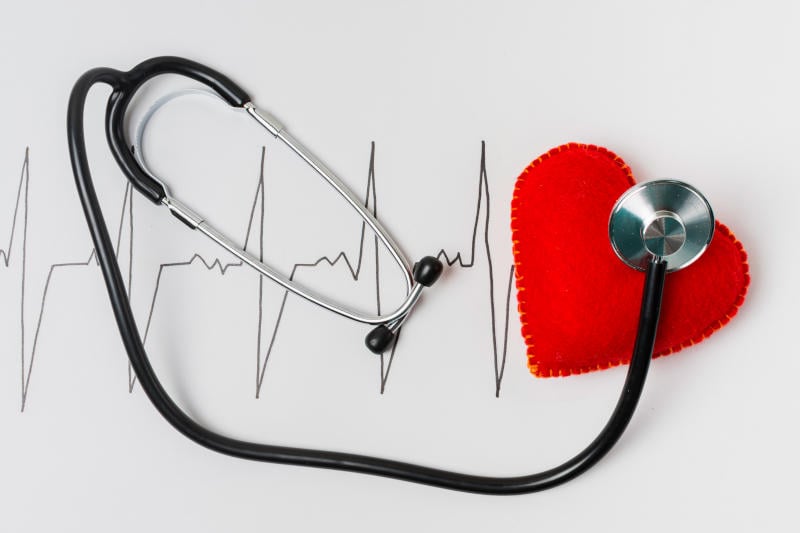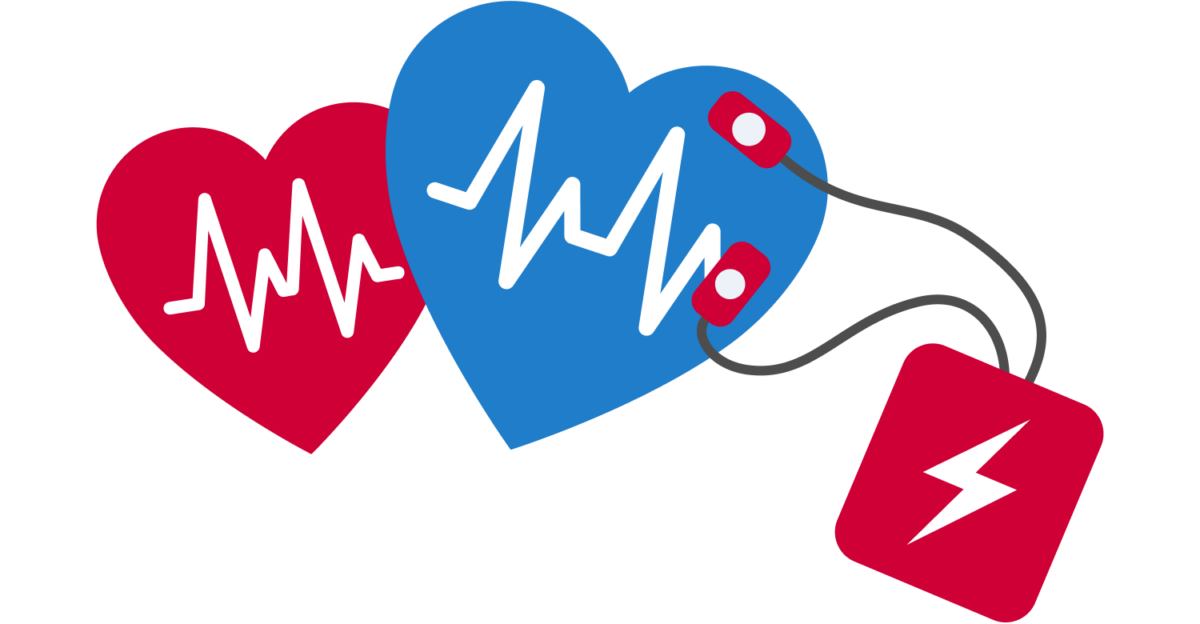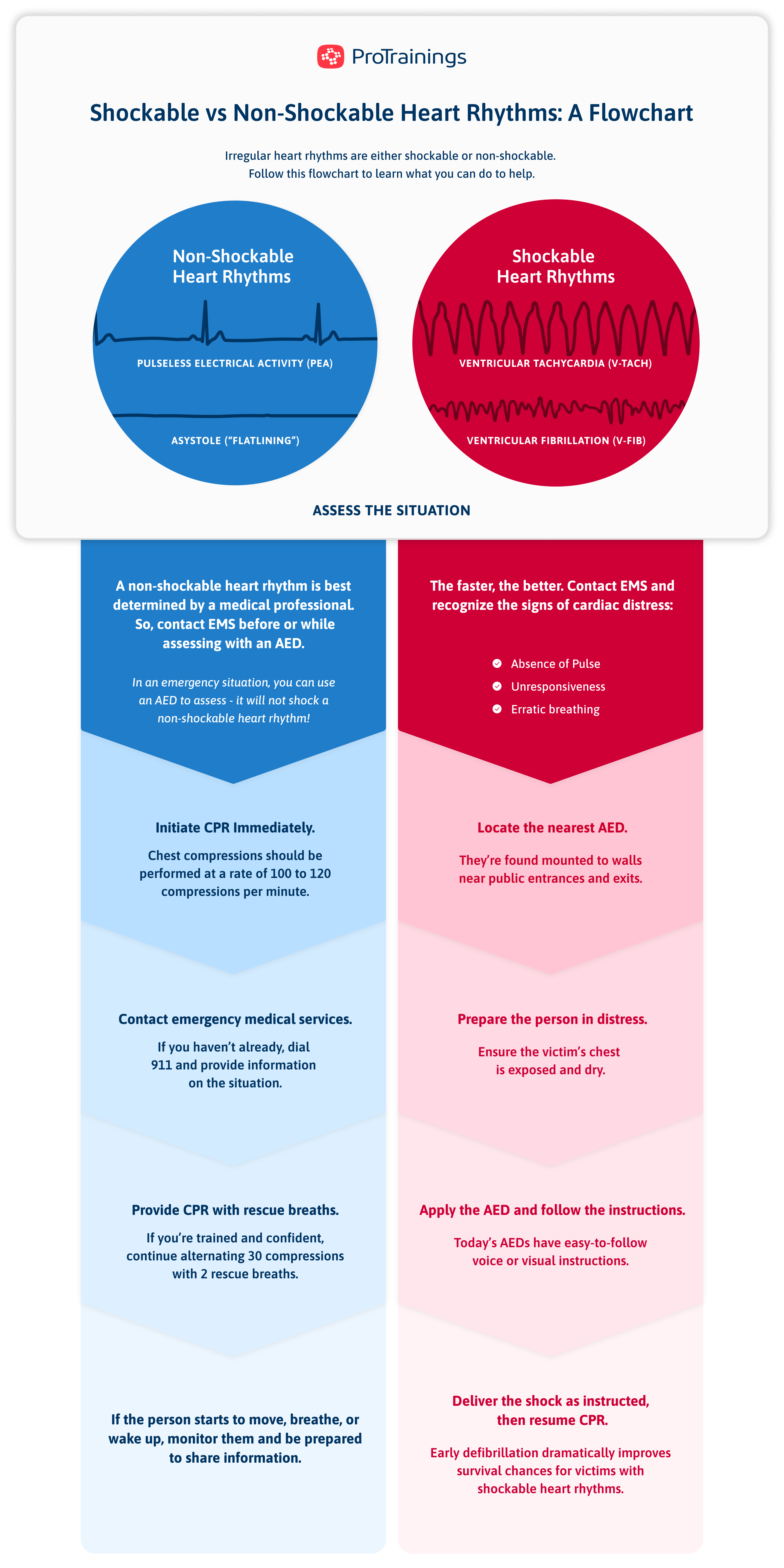Table of Contents
- Defining Defibrillation
- The 3 Types of Defibrillators
- Regular vs. Irregular Heart Rhythms
- Irregular Non-Shockable Heart Rhythms
- Irregular Shockable Heart Rhythms
- What to Do in Cardiac Emergencies
- When to Use an AED and Where to Find One
An irregular heart rhythm can cause serious health problems. In the case of cardiac arrest, a shock from an automated external defibrillator (AED) can reset the heart until further medical assistance arrives. But only shockable heart rhythms respond to electric shock — and not all heart rhythms are shockable.
Studies show that if performed immediately after a person has gone into cardiac arrest, CPR can double or even triple his or her chances of survival. And while the AED itself is designed to detect shockable heart rhythms from non-shockable ones, it’s worth knowing the hallmarks of the different irregular heart rhythms if you’re ever faced with an emergency.
Read on to learn the difference between shockable versus non-shockable heart rhythms and what CPR givers can do when confronted with these types of cardiac arrests.
Defining Defibrillation
What is defibrillation? Defibrillation is performed as part of basic and advanced cardiac life support (ACLS) protocols during cardiac arrest.
Defibrillation delivers an electrical shock to the heart, which stops chaotic electrical impulses.
Defibrillation temporarily allows the heart’s sinus node, or its natural pacemaker, to restore itself to a normal rhythm. Two types of shocks used during these emergencies are monophasic and biphasic.
Types of Shocks
When resetting the heart during emergencies, One of two types of electrical shocks may be delivered: monophasic and biphasic. While they have their differentiators, they both aim to achieve the same goal – restoring a normal heart rhythm during life-threatening cardiac emergencies.
Monophasic Defibrillation
In monophasic defibrillation, the electrical shock gets delivered in a single direction, either from a positive to a negative electrode or vice versa. Historically, monophasic defibrillators were more commonly used. They provide electrical energy in one direction and require higher energy levels than biphasic defibrillators.
Biphasic Defibrillation
Biphasic defibrillation delivers an electrical shock that changes direction midway through the shock waveform – the current flows first in one direction and then reverses direction. Biphasic defibrillators have become more popular due to their increased effectiveness at lower energy levels than monophasic defibrillators.
This results in less damage to the heart tissue, avoiding the risk of burning and increasing the chances of success in restoring a normal heart rhythm. Biphasic defibrillators can adjust the waveform based on impedance, or resistance to current, and response to therapy.
To deliver the necessary shocks to the heart, trained individuals must use defibrillators correctly. Properly used defibrillators ensure that monophasic and biphasic techniques restore normal heart rhythm during emergencies.
The 3 Types of Defibrillators
Defibrillators are medical devices that deliver an electrical shock to the heart to restore normal rhythm in cardiac arrest or severe arrhythmias. There are three types of defibrillators: a manual defibrillator/monitor, an automated external defibrillator (AED), and an implantable cardioverter-defibrillator (ICD).
Manual Defibrillator/Monitor
These are typically used by advanced healthcare professionals. Manual defibrillators require the user to interpret the heart rhythm using an electrocardiogram (ECG) monitor and determine whether a shock is needed.
The user then manually selects the appropriate energy level and delivers the shock by pressing a button. Manual defibrillators offer more flexibility and control over the shock delivery process, allowing for customization based on condition.
Automated External Defibrillators (AED)
You’ll find AEDs in thousands of public spaces across the country, which are to be used in the event of a cardiac arrest. When someone’s heart stops beating properly and falls into an unusual rhythm, this is classed as cardiac arrest. AEDs can restore a normal rhythm but don’t work on every type of irregular heart rhythm.
The AED will detect whether a rhythm is “shockable.” It will administer an electrical current to victims with shockable heart rhythms, and it will not shock in the case of a non-shockable heart rhythm.
Learn more about AEDs and what it looks like to use one correctly in this video:
Implantable Cardioverter-Defibrillator (ICD)
Unlike manual and AEDs, which are external devices, ICDs get implanted inside the body.
ICDs are used for long-term management of certain cardiac conditions, particularly for those at high risk of life-threatening arrhythmias.
ICDs continuously monitor the heart rhythm and can deliver a shock automatically if they detect a dangerous arrhythmia, such as ventricular fibrillation or ventricular tachycardia. In addition to defibrillation, ICDs can also function as pacemakers, delivering pacing pulses to regulate the heart rate if it becomes too slow.
Cardiologists typically perform ICD implantation during a surgical procedure, and the device is programmed to suit individual needs.
Each type of defibrillator serves a specific purpose in managing cardiac emergencies, ranging from immediate response in public settings to long-term monitoring and intervention for individuals with certain cardiac conditions.
Regular vs. Irregular Heart Rhythms
In adults, a “normal” resting heart rate ranges from 60 to 100 beats per minute, according to Mayo Clinic. Normally, the heart beats in a regular fashion and keeps a certain rhythm. An irregular heart rhythm, on the other hand, happens when electrical impulses in the heart become too fast, too slow, or irregular.

Some irregular heart rhythms are considered a common byproduct of aging and are known as arrhythmias. Further, some irregular rhythms are shockable heart rhythms, which can be corrected by AED-administered shocks, while others, unfortunately, cannot.
Ever wonder what irregular heart rhythms look like? Our PDF will help you visualize what’s happening to the heart.
Irregular Non-Shockable Heart Rhythms
Not all irregular heart rhythms will result in cardiac arrest or require the use of an AED. There are two main types of irregular non-shockable heart rhythms that present themselves through cardiac arrest. Once the AED is placed, it will analyze the heart rhythm and if it is a non-shockable rhythm, the AED will say “no shock advised”.
Pulseless Electrical Activity (PEA)
During PEA, the heart stops because its electrical activity is too weak to make the heart beat, thus sending the person into cardiac arrest. When this occurs, the victim will no longer have a detectable pulse. This is a harder condition to treat because it presents with apparent but misleading electrical activity on an ECG.
Asystole
Commonly known as “flat lining”, asystole means there is no electrical or mechanical heart activity to detect. This is the most severe form of cardiac arrest due to the lack of electrical activity which is required to initiate any contractions of the heart muscle.
Victims with asystole (non-shockable) heart rhythms have a very poor chance of survival, with only 10% surviving to the point of hospital admission and 2% surviving to the point of hospital discharge, according to studies.
Irregular Shockable Heart Rhythms
On the other hand, irregular shockable heart rhythms can be treated by a shock via an AED. In these cases, an AED shock can correct the heart’s rhythm, allow the heart to get more oxygen to the brain, and give the person more time before medical assistance arrives. There are three forms of shockable heart rhythms: ventricular tachycardia, ventricular fibrillation, and supraventricular tachycardia.
Ventricular Tachycardia
Ventricular tachycardia, also known as V-Tach, often responds well to defibrillation. Most people who suffer V-Tach are unconscious and without a pulse. In this case, the heart can be “reset” by using an AED. Multiple shocks may be necessary to treat this type of heart rhythm.
Ventricular Fibrillation
Ventricular fibrillation, or V-Fib, is a common cause of cardiac arrest and is best described as the heart “quivering,” which means no blood is pumped out of the heart. Often mistaken for asystole, V-Fib can be corrected by AED shocks.
If you’re worried about accidentally using an AED on a victim with a non-shockable heart rhythm, know that AEDs are engineered to know the difference.
AEDs can distinguish between shockable and non-shockable heart rhythms and will only administer a shock to someone with a shockable rhythm.
What to Do in Cardiac Emergencies
In the moments following a cardiac emergency, knowing what steps to take can mean the difference between life and death. Understanding how to respond effectively to shockable and non-shockable heart rhythms is critical.
Visualize the treatment process for both shockable and non-shockable cardiac emergencies with our flowchart.
Below, we outline clear guidelines for action, equipping you with the knowledge needed to navigate these high-pressure situations with confidence and skill.
Shockable Heart Rhythms
When encountering a shockable heart rhythm, immediate action is crucial. Here’s what you should do:
- Recognize the signs to ensure quick intervention. Absence of pulse, unresponsiveness, erratic or absent breathing, no signs of circulation and loss of consciousness are the most obvious signs of cardiac distress.
- Locate the nearest AED. These devices are strategically placed in public spaces for easy access during emergencies.
- Prepare the person in distress. Ensure the chest is exposed and dry. Remove any clothing or objects that might interfere with the electrode pads.
- Apply the AED and follow the instructions. The AED’s voice prompts or visual instructions will explain how to attach the electrode pads to the chest. The AED will analyze the heart rhythm to determine if a shock is necessary.
- Deliver the shock as instructed. Ensure no one is in contact with the victim before pressing the shock button.
- Resume cardiopulmonary resuscitation (CPR). Immediately after delivering the shock, resume CPR following standard guidelines until emergency medical services arrive.
Remember, early defibrillation dramatically improves the chances of survival for individuals experiencing a shockable heart rhythm.
Non-Shockable Heart Rhythms
Non-shockable heart rhythms require a different approach. Here’s what to do when encountering a non-shockable rhythm:
- Identify the rhythm. Identify non-shockable heart rhythms by recognizing indicators such as a flatline on the monitor, lack of palpable pulse, absence of ventricular activity, prolonged absence of cardiac output, and persistent asystole.
- Initiate CPR immediately. Chest compressions should be performed at a rate of 100 to 120 per minute with minimal interruptions.
- Contact emergency medical services. Or, instruct someone to call for you while you continue CPR.
- Provide CPR with rescue breaths. If you’re trained in CPR with rescue breaths, provide ventilations at the appropriate ratio following the latest guidelines.
- Monitor the victim’s condition. Stay vigilant until EMS arrives, and be prepared to adjust your actions accordingly.
- Share information with EMS. Provide emergency services with relevant information and continue to assist as needed until further medical interventions begin.
Again, early CPR and effective teamwork can make a significant difference in the outcome of individuals with non-shockable heart rhythms.
When to Use an AED & Where to Find One
To know when to use an AED, attach it to the person experiencing cardiac arrest. Remove their clothes, making sure their chest is dry, and the AED will detect whether a shock may be administered. The AED won’t deliver a shock unless it detects one of the shockable heart rhythms.
See an AED in action with our Adult AED video.
AEDs are typically found in public spaces like leisure centers, shopping malls, and public buildings. They’ll be marked with a green “AED” sign and a graphic of a white heart being split by a lightning bolt. You should be able to access them 24 hours a day.
Although not all cardiac arrests can be helped by administering an AED shock, everyone can benefit from knowing the difference between shockable and non-shockable heart rhythms and how and when to use an AED. Contact us today to learn more about how ProTrainings can help you make getting your staff CPR certified easier and more efficient.

